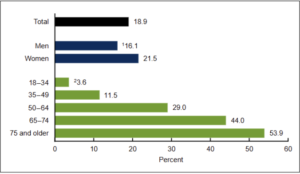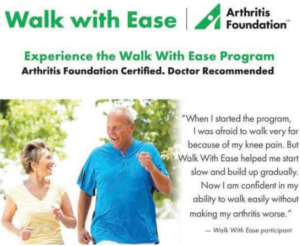Different Ways to Prevent Arthritis in the Beginning Phases
Written by: Sahasra Janagama
Rheumatoid Arthritis, or RA is the most common type of arthritis, although it’s usually given the title of “wear and tear” or “old age disease”, the breakdown of the joints is caused by pain, swelling, and soreness of bone which increases overtime, gradually. The objective of this article is to show ways to prevent arthritis in the beginning phases, and how long certain physical actions can affect the first phase of arthritis. This is an observational study focused on collecting data of past years, and notice patterns of major setbacks to living a long life pain-free. Furthermore, it focuses on the various factors that play a role in RA and how to reduce them on a daily basis.
What is Arthritis and Data from the Past
There are over 100 types of arthritis the most common being RA, which has an effective 1/3 of the American population. RA deals most often with the wrists, hips, and knees, it can happen due to the breakdown of the joint cartilage. Basically what happens when you flick your wrist, or walk, the two bones rub against each other, but thanks to the cartilage which serves the purpose of being a cushion, it protects direct contact of bone to bone.
The target population of this study is of all ages, and can be most useful to the younger generation, while being most effective to the older generations. The data was collected through many different mediums, from personal stories of fighters who had RA to statistics that not only trace back the rate of RA but also predict 2030s RA patients. It was analyzed through an objective perspective by observation of trends throughout the years, major risk factors affecting different populations, history of a diagnosed patient’s life, and a conclusion is made about different ways of prevention by references of previous data collected. RA can only be observed and not experimented on, this makes the study biased when talking about “solutions”, as they can only be seen externally instead of the molecular level. However, surgery can be done to slow down the process of arthritis, although it is a fairly new concept and researchers have only scratched the surface of having a deeper knowledge about the key enzymes that act upon the beginning phases of RA (The Burden of Rheumatoid Arthritis: Findings From the 2019 Global Burden of Diseases Study and Forecasts for 2030 by Bayesian Age-Period-Cohort Analysis, 2023).
Figure 1

Arthritis in Adults Age 18 and Older: United States, 2022
Source: CDC
Result
Most of the data supports different physical actions that can be done on a daily basis to help maintain a stable physical health. Due to arthritis being different for each individual and can be diagnosed from a wide age range of 18-46, the solutions provided can vary for time, ability, and usage. The infographic below is from a foundation that also supports the solution of increasing physical fitness. Since arthritis becomes more aware with age, it’s best to start doing some of these listed actions from a young age. So the ways to prevent arthritis non-surgically, or to reduce the pain are:
- Healthy Diet – Vitamin D and E have shown a decline in the amount of inflammatory response in the joints.
- Assistive Devices/Braces – Help reduce the amount of pain, and can help decrease the amount of work limitations.
- Activity/Exercise – Keep the joints engaged, and maintain function, but be cautious and do in moderation if only started for a short amount of time.
Some other options would be concerned in the surgical field, however since this research is focused on the beginning phases aspect alone, these solutions suffice for the starting of pain and swelling (Arthritis and Its Public Health Burden – PMC, n.d.).
Figure 2

The Ease Program is a way to start physical activity started by the Arthritis Foundation.
Source: Arthritis Foundation
Conclusion
The major conclusion of this observational study is how much a single habit can affect a person’s chance of having RA. It’s important to recognize that other than surgery, the best solution to preventing RA from worsening is simply to get more physical activity in, having a healthier diet, maintain a healthy weight, and continuing to educate about health management on a constant basis. It’s interesting to see how such simple habits have the same effect as receiving surgery for over a long period of time, and it’s important to note that no matter the time period whether it’s only the beginning or the last phase it’s the same principle, as the goal stays the same to only ease the pain. This study concluded on how RA cannot be prevented but decreases the chances of getting it and decreases the amount of pain and swelling that will occur. This opens a door of possibilities of what a person can do with their daily life other than saving money for surgery! So workout to live a day longer without needing others help, to become stronger by the day and just moving will be a small favor for a person’s own future self.
References and Sources
Arthritis and its Public Health Burden – PMC. (n.d.). NCBI. Retrieved September 13, 2024, from https://www.ncbi.nlm.nih.gov/pmc/articles/PMC8352468/
Pre-rheumatoid arthritis and its prevention – PMC. (n.d.). NCBI. Retrieved September 13, 2024, from https://www.ncbi.nlm.nih.gov/pmc/articles/PMC5473457/
Recovery From Rheumatoid Arthritis Following 15 Months of Therapy With Low Doses of Ionizing Radiation: A Case Report. (2018, July 8). NCBI. Retrieved September 13, 2024, from https://www.ncbi.nlm.nih.gov/pmc/articles/PMC6043934/
The Burden of Rheumatoid Arthritis: Findings from the 2019 Global Burden of Diseases Study and Forecasts for 2030 by Bayesian Age-Period-Cohort Analysis. (2023, February 6). NCBI. Retrieved September 13, 2024, from https://www.ncbi.nlm.nih.gov/pmc/articles/PMC9959633/